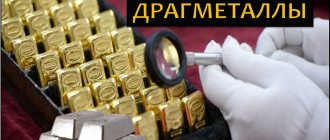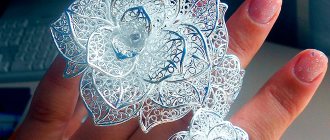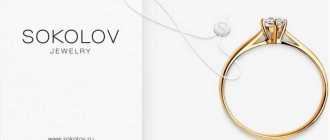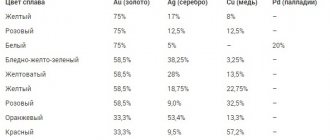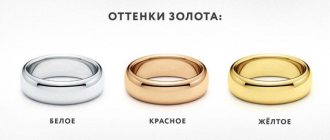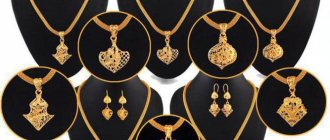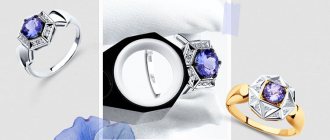Silver samples
Pure silver is a metal so impractical that it quickly loses its shine and is easily scratched. Plus, any jewelry made of silver of the highest standard, when rubbed against clothing or touched, wears out and loses its relief.
Jewelers use alloys of silver with other metals to strengthen the product, making it durable and more beautiful. Typically, the alloy for silver jewelry is cadmium or copper. The latter is sometimes replaced with zinc, nickel or aluminum.
Cadmium improves the expressive properties of silver, but at the same time significantly increases the cost of the product. Therefore, the most popular additive is copper.
The higher the silver standard, the lighter and brighter the jewelry. If you are offered a product with a reddish tint, most likely it contains 50% copper or more.
Platinum samples
Platinum has only one fineness in the metric system - 950. In the carat system, the metal has no fineness at all. Why? Because platinum is a strong metal that does not deform and will not lose its shine over time. It doesn't need to be mixed with anything.
Due to its density, platinum is slightly heavier than gold and weighs almost twice as much as silver. It is many times more expensive than these metals. Platinum is rarely used in jewelry.
All about the sample
The sample, indicating the content of precious metals in a piece of jewelry, is one of the main characteristics of any jewelry. Therefore, every buyer should have at least a small understanding of samples.
Throughout the history of mankind, in addition to the metric system of samples, which we will discuss below, three more have been used:
* Spool
* Lot
* Carat.
The spool testing system appeared in Russia in 1711, first for silver alloys, and since 1733 for gold alloys. This system relied on the precious metal content based on the number of spools in one pound of alloy.
A zolotnik is a Russian measure of weight equal to approximately 1/96th of a pound. Accordingly, gold in its pure form is 96 samples. For gold in Russia in those days, 56, 72, 92, 94 samples were used.
This measurement system existed until 1926.
Another now defunct sampling system is the lot system. It was common in the Middle Ages in Germany and was used for branding silver items. The content of pure precious metal was determined by the number of lots. The maximum sample of pure silver was 16 lots.
The carat system also has German “roots” (not to be confused with carats for precious stones). Unlike the spool and lot systems, the carat system is still used today. This system is common in the USA, Great Britain, Italy and some other countries.
In this system, pure gold corresponds to a purity of 24 carats. There are the following samples of the karate system: 6 k, 8 k, 10 k, 12 k, 14 k, 18 k, 22 k.
The most common system currently used is the metric system. This is exactly what is used in Russia. In this case, the content of pure precious metal is determined by the number of grams in one kilogram of jewelry alloy. Pure precious metal corresponds to 1000 fineness.
In the metric system, the first two digits indicate the percentage of noble metal in 1000 parts of the alloy. Products of the 750th standard contain 75% pure gold, and products of the 585th standard contain 58.5%, etc.
Within the metric system, the following hallmarks are used for gold: 1000, 958, 900, 750, 585, 500, 375.
Pure gold (1000 purity) is not used in jewelry production: it is too soft and can break. 958 gold alloy is used to create works of art, while 900 gold is most often used to make dentures.
In jewelry you can most often find alloys of 750 and 585 samples. It should be remembered that gold alloys of different grades can be of different colors depending on the quantitative ratio of non-ferrous metals contained in them.
The following standards are used for silver in Russia: 800, 830, 875, 925, 960, 999. The most common alloy is 875 silver. It is used to make decorations and tableware items.
Buyers should take into account that any piece of jewelry produced in Russia must have a state hallmark (assay mark). This is a special mark that is minted on jewelry by state assay inspections.
The absence of a sample means that this is a fake product, the quality of which is in no way guaranteed.
For hallmarking, hallmarks of various shapes and designs are used in various countries. In Russia since 1994, this is a woman’s head in a kokoshnik.
Detailed information about jewelry samples is available in each jewelry showroom of our company. Also, our salespeople will always answer your questions.
Sterling (English: Sterling [silver]) is the name of an alloy of 92.5% or higher silver and 7.5% other metals, usually copper (925 silver and higher). Pure .999 silver is too soft for large items, so it is usually alloyed with copper to add strength while maintaining the ductility and beauty of the precious metal.
As an alloy, instead of copper or together with it, attempts were made to use other metals to improve quality - reduce porosity, increase wear resistance, to tint the color, eliminate blackening. For these purposes, germanium, zinc and platinum, titanium, as well as various additions - silicon, boron - were used. However, the de facto standard remains an alloy with added copper.
Palladium samples
You will hardly find jewelry made from palladium anywhere, but this metal is still worth mentioning.
Pure palladium is lighter than gold, silver and platinum. Almost any mechanical impact can deform it. Even friction. In the metric system it has two samples, and in the carat system it has one. Palladium has a silvery-white color.
Palladium
A ductile noble metal of white color, found in nature 10 times less frequently than gold and 40 percent lighter. Discovered by the English chemist William Wollaston in 1803. Named after the asteroid Pallas, discovered shortly before the metal itself. In turn, the asteroid is named after the Greek goddess Pallas Athena.
Palladium 950 is an ideal replacement for rhodium-plated gold.
White gold itself is not white. In order for jewelry made from it to have the familiar silvery white color, each product is coated with a thin layer of rhodium, which gives it this color. The original color of “white gold” in alloys produced in our country has a yellowish tint, which occurs due to the use of nickel as an alloy. The use of nickel is determined by the desire to reduce the final cost of the alloy as much as possible while giving it a white color and certain mechanical properties.
But it is not possible to achieve complete whiteness; moreover, nickel is the most allergenic metal of all existing ones. Therefore, to protect the skin and achieve a silvery white color, jewelry is rhodium plated.
In Western European countries, where the health of end consumers is much more concerned, the use of nickel in the creation of jewelry is prohibited at the legislative level. There, palladium is used in the ligature, which gives “white gold” a dark gray tint. Such products are then rhodium-plated to give them a silvery white color. In addition, in order to achieve optimal hardness of the alloy and maintain the ability for ordinary jewelers to work with it, the percentage of palladium in the alloy does not exceed 18%.
Rhodium coating, like any other coating, wears out over time. And if for earrings, pendants and chains the wear period of the coating can be very long, then for wedding rings, which, as a rule, are not removed at all, the issue of how long the coating wears out is very significant. Therefore, the main question facing jewelers today is achieving a silvery white color without coating, with appropriate hardness and safety for humans.
There is no such solution for gold yet, but it was found using Palladium 950
In 2007 In Germany, the Palladium 950 alloy was developed for the production of wedding rings, which solves all these problems, except one - ordinary jewelers cannot work with it, since the alloy is not cast, but requires mechanical processing. In Russia, all wedding rings are mostly produced using casting, and in Europe by processing specially made blanks on robotic machines.
Palladium 950
— Noble metal of the platinum group.
— Palladium is as rare as platinum.
- Absolutely anti-allergenic.
— The alloy contains 950 fineness – 95% pure palladium.
— The cost is the same as 750 gold (75% pure gold in the alloy).
— The hardness is almost like that of platinum 950 (PtW Germany), and higher than that of Russian platinum 950 (PtCu) by 80%, Russian gold 750 by 70%, than that of German gold 750 by 25%.
— The color without coating is silvery white, like rhodium plated products.
In Russia, 850 standard palladium is used to make jewelry.
Products are made mostly by stamping to give the metal hardness.
What is important to know about sterling silver
You will definitely come across the phrase “sterling silver” or “sterling silver”. This alloy of 925 precious metal is the most popular material for making silver jewelry. Modern manufacturers create both decorations and cutlery from it. The products are bright, durable and practically not subject to mechanical stress.
There are several versions of the origin of the name “sterling silver”. Some researchers
It is believed that from this sample in the 14th century the British mint minted coins called sterling. The second version has German roots.
In any case, silver of this standard has proven its worth many centuries ago.
In what form can platinum be sold in Moscow?
Before selling platinum in Moscow, experts strongly recommend choosing a professional company that buys platinum. Antique store Golden Council is a veteran of the antique market. The company is constantly increasing its turnover in the platinum purchasing segment in Moscow and expanding the range of its offerings.
The company accepts the following platinum jewelry for purchase:
- A variety of jewelry, bracelets, watches.
- Platinum rings, with stones, engravings, pollination and inlay.
- Platinum earrings.
- Women's and men's chains made of platinum.
- Mesh, wire, thermocouple.
- Crucible, platinum technical waste and relay contacts.
Each product has its own hallmark; scrap platinum also requires taking this factor into account. The expert draws attention to three numbers that characterize the material:
850 standard platinum.
This material is actively used in industry because it has more than 15% impurities and is considered a dirty alloy.
900 platinum
Products made from this material are dull, so jewelers do not give preference to the material with an average percentage of additives of 10%.
950 platinum
Recognized as a standard for use in the jewelry industry. Products made from this type of metal are distinguished by their brilliance and beauty. The material is compared to a 22 carat sample. The purity of the material is justified by the practical absence of various impurities. This is considered the purest alloy possible.
999 purity platinum
A fairly rare alloy that is rarely found. In most cases, this material is presented in expensive ingots.
Summarize
- The higher the grade indicated on the product, the more precious metal it contains.
- The more silver in the item, the more likely the jewelry is to wear out.
- A real piece of jewelry can only be stamped with a standardized hallmark, without deviations in the numbers.
- The bright color of the product indicates a minimal amount of impurity in the metal.
- Platinum is a metal so hard that it does not require a ligature.
- Platinum is heavier than gold and silver.
- The most popular silver is sterling.
In the following material you will learn everything about precious and semi-precious stones. Learn to appreciate processed and untreated crystals.
Stay tuned for our next article!
<< Return to list of articles
Gold
What is gold? This, of course, is jewelry sold in jewelry stores, adding a special charm to beautiful ladies and elegant men. But besides this, this is also an investment, because the cost of gold per 1 gram not only did not fall during the last crisis, but also began to rise. And yet, many people buy gold simply because it is pleasant to wear these beautiful products. Costume jewelry, of course, also looks good, but gold has always been valued in all countries more than simple trinkets. Gold is a style, it’s an effect, it’s just beautiful.. In stores now there is such a variety of different metals and their alloys that it’s dizzying. But the queen of the showcase has always been and remains to this day 585 gold. This is the standard of value, and even platinum jewelry cannot compare to it. Jewelers work with time-tested materials and achieve perfection in this. Refined gold pendants, sparkling on the blue velvet of the display case, will attract the eye of the most sophisticated fashionista. A whole arcade of cushions with earrings, in which precious and semi-precious stones shimmer, also beckons. You will find chains to suit every taste. And rings and rings are a completely separate conversation - you will find such a variety that our grandmothers never dreamed of in their time. By buying gold jewelry to your significant other, you make it clear the value of your relationship, the seriousness of your intentions, and simply make it pleasant. Of course, the cost of a gram of gold cannot be compared with the cost of your feelings, but still it will emphasize tenderness and love.
Gold samples
Gold is the only metal that has a beautiful bright yellow color in its pure form. When polished, a product made from it acquires a beautiful shine. Gold has the most valuable property - it is chemically resistant, i.e. does not oxidize in air, does not rust in water, does not react with salts, acids and alkalis. There is no allergy to gold jewelry with a high gold content. The only thing in which gold dissolves is “regia vodka” from a mixture of hydrochloric and nitric acids.
However, despite all these wonderful qualities, pure gold (1000 carat) is never used in the production of jewelry - such jewelry, due to the natural softness of the metal, is subject to rapid abrasion and is easily deformed. Therefore, gold is usually used in the form of its alloys with other metals.
In Russia, as in many countries of the world, a system of metric gold samples has been adopted. The first two digits in the metric system indicate the percentage of gold in 1000 parts of the alloy of this noble metal. Thus, 750-carat gold contains 75% pure metal, the remaining 25% is impurities.
Traditionally, jewelry is made from alloys of 750 and 585, or, much less frequently, from 500 and 375.
In our Jewelry Store you can purchase jewelry made from 585-carat gold, as well as jewelry that uses 750-carat gold, the price per gram of which is quite reasonable. The gold purity, confirmed by the State Assay Inspectorate (GIPN RF), is indicated on the stamp of each piece of jewelry.
